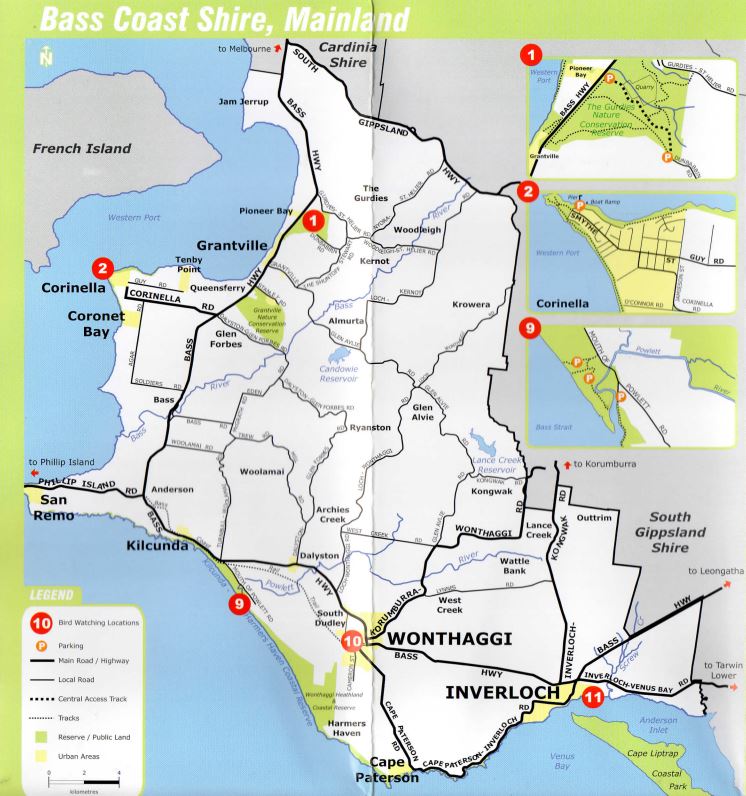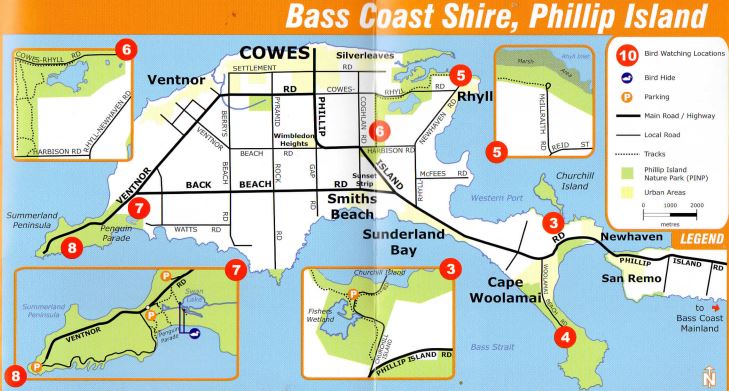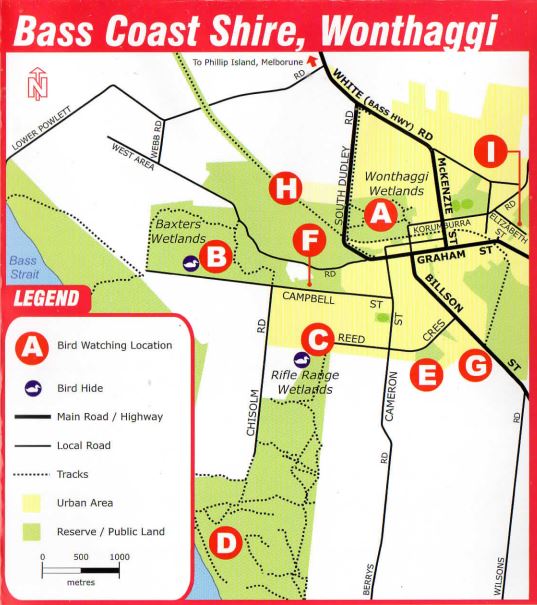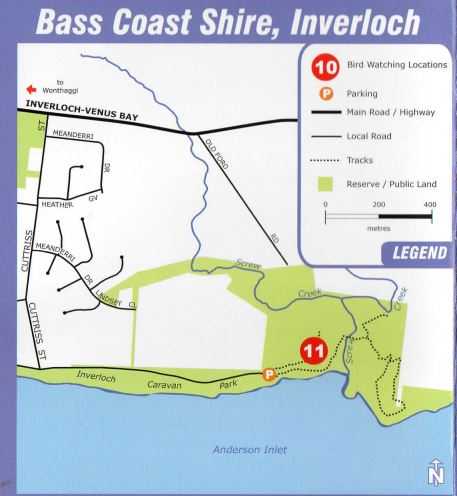Bass Coast Bird Trails

The Bass Coast abounds with a wide variety of birds.

1. The Gurdies Nature Reserve
This reserve protects one of the few significant remnants of coastal woodland on Western Port. There is a small wayside stop opposite Pioneer Bay on the Bass Highway. Another access point is via Dunbabbin Road, off Stuart's Road. There is a good parking area with magnificent views over Western Port. Near the top of the main trail a side track to the north leads to a gully where Bassian Thrush, Rufous Fantail and Eastern Whipbirds can be found.
Other birds seen in The Gurdies Nature Reserve include parrots, thornbills, robins, treecreepers, sittellas and honeyeaters. Raptors can be seen overhead and Powerful Owls have also been sighted. An added bonus for plant enthusiasts is the wide variety of orchids flowering throughout much of the year.
2. Corinella Foreshore Reserve
Cars may be left at either end of this 3-4 km walk, at O'Connor Road or Jamieson Street. Alternatively starting at the jetty carpark allows the walk to be done in two shorter sections. The northern section, from the rotunda to Jamieson Street, leads to a regenerating heathland. Beach and seabirds roost and feed among the mangroves, while small scrub birds are returning to the heathland.
To reach the southern section, walk or drive along the road past the caravan park to Settlement Point, then follow the track along the southern coast on the high cliffs. The track passes through a variety of habitats, including low coastal scrub, native grassland, she-oak dominated coastal woodland and, finally, a substantial stand of Coastal Banksias at O'Connor Road. (The walk can be extended to Coronet Bay). The bird list includes a variety of bush and scrub birds. An occasional sea eagle may be seen.

3. Fisher's Wetland
Two wetlands adjoin the road to Churchill Island. Fisher's Wetland is on the left side of the road. It is a large wetland, which dries out, leaving a few deep holes with permanent water during prolonged dry seasons.
Three tracks leave the carpark. One skirts the north-eastern edge of Fisher's Wetland on a boardwalk and continues into bushland. The second crosses the road and leads to the bridge via a boardwalk beside a saltmarsh. A third track leaves the northern end of the carpark leading to a birdhide overlooking the western side of the wetland and on to the end of Churchill Road through saltmarsh beside Swan Bay.
4. Cape Woolamai Peninsula
Parking in the southern carpark of the surf beach allows easy access to a number of walking tracks on the peninsula. Hooded Plovers are often seen on the ocean beaches and the walk to the headland often rewards birdwatchers with views of a range of raptors, including White-bellied Sea-Eagle.
Keep a lookout for albatross and other pelagic birds, especially in winter. At dusk, from September to April, vast flocks of Short-tailed Shearwaters can be seen returning to their rookeries on the clifftops.
5. McIllraith Rd / Rhyll Inlet
Access this spot from the intersection of Cowes-Rhyll Road and Rhyll-Newhaven Road. Take the road heading north from this intersection and follow the first dirt road on the left (Mclllraith Road). Park at the end of the road and look over the entrance of Rhyll Inlet. At high tide the sand pit and rocks are popular wader roosts and in summer a range of international waders can be seen. A telescope or good binoculars will be useful here.
Follow the track to the west for an interesting bird walk with great scenery. It leads down to boardwalk among the mangroves and rejoins the track to Conservation Hill carpark and a lookout overlooking Rhyll Wetland, a large nesting site for ibis in a wet spring season.
6. Oswin Roberts Reserve
This reserve on Harbison Road, bought by Florence Oswin Roberts in the 1930s to protect the koala habitat, is the largest accessible bushland left on Phillip Island. Several tracks lead through the reserve. Birds often seen include a variety of honeyeaters, parrots, thornbills, pardalotes, silvereyes and other bush birds.
7. Swan Lake
About halfway between the two roundabouts near the Penguin Parade you will find the carpark for Swan Lake on the south side of the main road. Park there and follow the short, well marked track through coastal bush to two birdhides looking onto Swan Lake. Take your time to find a great range of ducks, teal, Cape Barren Geese, wrens, grebes and raptors.
8. Summerland Peninsula Circuit
This peninsula covers the western end of Phillip Island. The Penguin Parade is at the entrance. From the roundabout, follow the sealed road west. Turn off to the Cat Bay carpark (about 500 m from the roundabout) and park facing the old jetty in Cat Bay. Various cormorants, including Black-faced Cormorant, often rest on the posts.
Return to the main road and continue west. Other carparks along the cliffs lead to interesting beaches. Park at The Nobbies carpark and explore the boardwalks. Watch out for Crested Terns gannets, gulls (Pacific, Kelp and Silver), Little Penguins and Sooty Oystercatchers which roost and nest in this area. Use your binoculars or a telescope to check out the seals on Seal Rocks.
For a bit more adventure, travel along the track back to the Penguin Parade, stopping at any of the lookouts. These are good spots to sea-watch for albatross, gannets and jaegers. Watch out for raptors over the peninsula.
9. Mouth of the Powlett River
Situated on the Bass Highway between Kilcunda and Wonthaggi, this is an excellent site with a range of habitats. Ocean beaches (Hooded Plovers), river flood plains (Blue-winged and Orange-bellied Parrots) and banksia groves (honeyeaters and thornbills) offer a range of interesting birds.

Wonthaggi is fortunate to have three wetlands within a short distance of the town.
A. Wonthaggi Wetlands, off South Dudley Road are close to the main road and have easy walking tracks. There is a variety of water and bush birds.
B. Baxter's Wetland is reached by driving to the western end of Campbell Street and walking a short distance through regenerated bush. Some of the specials here have included Magpie Geese and Glossy Ibis. There is a bird hide with excellent morning views.
C. Rifle Range Wetland is accessed from the western end of Reed Crescent. This area is a part of the Wonthaggi Heathlands and was regenerated by direct seeding processes in 2005. There is a good bird hide and easy walking. In 2007 the species count was between 90 and 100 species.
Baxter's and Wonthaggi Wetlands have water all year round, but the Rifle Range water is very low in summer. A good selection of water birds and bush birds will be seen at each of the sites.
Crested Tern
D. Lying some 5 kilometres to the south-west of the town, the Wonthaggi Heathland is an excellent example of coastal landscape with a variety of different bird habitats. There is a network of very good walking tracks which lead you through dry and wet heathlands, coastal wetland, coastal dunes and actual beach front. You might catch a glimpse of a Southern Emu-wren in the heathland or a Hooded Plover on the beach. There are also honeyeaters, raptors, Eastern Rosellas, Blue-winged Parrots, wrens and thornbills.
There is also good birding to be found in some of the bush close to town:
E. Tank Hill, off Reed Crescent
F. Campbell Street bush running parallel to Campbell Street
G. Eastern Area Rail Trail, off Cape Paterson Road
H. Western Area Rail Trail, access opposite the Wonthaggi Wetlands
I. Wonthaggi Bushland Reserve off Elizabeth Street

11. Screw Creek, Inverloch
Screw Creek walking track is at the eastern end of The Esplanade. An excellent walking track leading through the camping area and across the creek takes you up to the Bluff where there are very good views across the inlet to Venus Bay and Point Smythe. Any number of small bush birds, gulls, egrets, White-faced Herons, honeyeaters and the occasional raptor can be seen.
Just across the bridge, to the right of the walking track, is a swash way where it is possible to catch sight of an emu-wren or Orange-bellied Parrot in the right season.
If you take the walk along the creek bank you also have the opportunity to see grebes, ducks and other waterfowl.
Warning! Please remember that snakes and other hazards are a vital part of any bird habitat and that care should always be taken when venturing into their territory.








